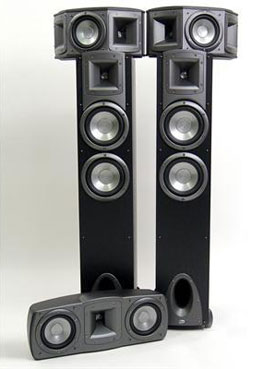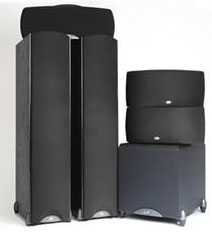 Klipsch Synergy Series Speakers Make Home Theaters Rock!
Klipsch Synergy Series Speakers Make Home Theaters Rock!
By Jim Bray
From the company that brought the world the mighty Klipschorn comes the Synergy
series of speakers, a most enjoyable way to experience your home theater's
audio.
The Klipschorn is about the size of a small car, taking up the entire corner
of the audiophile's room. Yet that hulking beast is also amazingly efficient – a
Klipsch hallmark from then until today.
I never reviewed the Klipschorn, though I've lusted after it from afar, but
I did review their old Forte series many years ago. I loved them, both for
their sound quality and their typical Klipsch efficiency; I said back then
that if I were to own them I'd be deaf before long. And loving it.
Part of the Klipsch legend comes from the company's use of horn drivers, which
can deliver high output with low distortion. High output indeed. My reference
speakers are no slouches, with a rated sound pressure level of 92 decibels.
And they play loud! Klipsch lists the Synergies at 97 dB.
What this means in practical terms is that the Klipsch will play LOUD. And
they won't break a sweat doing it.
I tested the Synergy series with two Rotel amps, the 200 watt per channel
RMB-1095 and the 100 watt per channel RMB-1077 – and I could get adequate
(read "really loud") volumes from the Klipsches at a lower volume
setting than the reference speakers required. And if you ran them at the same
volume as the reference speakers – hello!
The Synergies Klipsch sent me were enough to create a full 7.1 surround home
theater. They included a pair of Synergy F-3 front speakers ($424 U.S. each),
a C-3 center channel speaker ($330), two pairs of S-3 surrounds ($450 per pair)
and a Sub-12 subwoofer ($500). I came away from the test considering them to
be a heckuva deal.
The F-3's, which Klipsch refers to as "muscle cars" and "a
masterpiece of sound and design", are handsome floor standing "bass
reflex" speakers that feature two eight inch woofers, a one inch aluminum-dome
compression tweeter and Klipsch' famous 6.5 inch square high frequency Tractrix
horn. These are not only the heart of the home theater system, but they'll
also function nicely in a stereo listening environment.
The F-3's frequency response is rated by Klipsch at 35Hz - 23kHz +/-3dB, and
power handling is 150 watts continuous (650 peak). They can be bi-wired,
so you can use one or two speaker inputs (an audiophile thing by which you
send power separately to the low and high frequency speakers). I didn't bi-wire
them for my tests, though.
These are great rock 'n roll speakers – and I don't mean by that to say
they only shine with rock music. In fact, I loved how they sounded regardless
of what type of music I played, from The Who to Strauss, from big band to electronic.
But with rock music (and also with particularly dynamic recording from other
genres), there's a wonderful "punch" to the sound, a dynamism that's
a joy to hear.
They image well, too. On some stereo material they didn't just fill the room
with a nice, wide soundstage, but more than once the "ghost image" in
the center between them was so good that I got up and put my ear near the C-3
center speaker to see if it weren't actually playing as well. It wasn't.
The F-3's bass performance in standalone stereo mode is fine, but if you really
you’re your bass seriously you'll want to hook the Sub-12 subwoofer into
the system: your hair will stand on end.
That subwoofer is a beast: if you like your bass to shake your room, this
may be your sub. It features a 12 inch driver that fires toward the floor and
a "Class D" digitally-powered amplifier that puts out 300 watts of
continuous power (650 watts of dynamic power). The bass reflex sub's low-pass
crossover is adjustable from 40 to 120Hz and Klipsch says its sound output
is up to 117dB. And I loved it!
The rear panel features a large venting port, stereo RCA inputs, and stereo
speaker inputs and outputs, which is about as much connecting flexibility as
you could want. My reference speakers have built in powered subs that do a
wonderful job, but they have to take a back seat to the visceral Klipsch (dammit!).
The deep, rumbling bass goes down to the limits of audibility (my audibility
anyway!); Klipsch says its response ranges from 24 to 120Hz +/- 3dB. On music
and, especially, movies, the sub adds a wonderful kick, whether it be to bass
guitars or exploding planets.
The C-3 center channel speaker, and the S-3 surrounds, are good matches to
the F-3's.
The C-3 features two 6.5 inch woofers (magnetically shielded so they don't
put purple splotches on your TV screen), a one inch magnetically shielded aluminum-dome
tweeter and the horn. It's also bi-wirable and, in use, doesn't add any color
to the F-3's. The C-3 is great for reproducing dialogueand center channel information
when you're playing DVD-Audio or SACD discs.
Klipsch says the C-3's frequency response is 73Hz - 23kHz +/-3dB (so you'll
want the subwoofer), its power handling is 150 watts continuous and its sensitivity
is a robust 96.5 decibels.
Likewise, the S-3's – which are a lot larger than I had expected – are
big hemispheres that contain a pair of horn loaded aluminum-dome tweeters surrounding
a single 6.5-inch woofer. The horns are aimed at 90  degree angles from each
other to maximize dispersion. The S-3's frequency response is 62Hz - 23kHz
+/-3dB, power handling is 110 watts (440 peak) and their sensitivity
is "only" 93.5dB. They come with a keyhole bracket for wall mounting.
degree angles from each
other to maximize dispersion. The S-3's frequency response is 62Hz - 23kHz
+/-3dB, power handling is 110 watts (440 peak) and their sensitivity
is "only" 93.5dB. They come with a keyhole bracket for wall mounting.
Most home theaters can get away with one pair of surrounds but if you have
a larger room or really want to go for the gusto for discs with 6.1 and 7.1
soundtracks, the extra pair comes in handy. The S-3 do a nice job of spreading
the surround information through the room – though not at the expense
of rock steady placement when that's what the programming source demands.
I threw everything I had at the Synergy system, movies, concerts, CD's, DVD
Audio and SACD discs and it ate everything up and said "Is that all you
got?" We tried it at low volumes and what even I would consider an excessive
volume – and rather than rattle or squeak or – God forbid – turn
into little black rocks, they just played louder and louder.
Audiologists must love the folk at Klipsch!
The high and midrange frequencies are clean and crisp and lifelike and, as
mentioned, the bass was nearly enough to cause the heart to flutter. Imaging
was first rate and the overall experience was involving and engrossing. I did
notice that, perhaps due to the more "in your face" nature of horns,
I would experience more fatigue over long listening sessions with the Klipsch
system than with my reference system – and not everyone may like their
'brightness' – but everyone I played the Synergies for fell in love
with them almost immediately. I started wishing I had a Klipsch franchise….
Test material included DVD's of "Lord of the Rings ROTK" (those
Oliphants, the Nazgul and all those arrows and stuff flying around made me
want to duck), "The Who Live at Royal Albert Hall" and the Cream
Reunion concert (two of the best concert DVD's for sound quality and power),
several test CD's I've collected over the years, the remastered "The Who
Live at Leeds" and Dire Straits "Brothers in Arms," the SACD
of Pink Floyd's "Dark Side of the Moon" and DVD Audio discs including
Medeski, Martin and Wood's "Uninvisible" (hate the music, love the
audio), Eagles' "Hotel California," the Doobie Brothers' "The
Captain and Me" and Les Brown's "Session #55." And that's only
a partial list; as I said, I threw everything I had at them.
I must also mention the speakers' appearance. Though this shouldn't really
be a consideration, good lucks never hurt and I can be as superficial as the
next person (maybe more). And though the cabinets don't really ooze a high
quality finish that would cause an interior designer to swoon, the Synergies
still look very good with their grilles on.
But I ran them with the grilles off, for two reasons: with their titanium
accents, I thought they looked better that way – mean and ready for business – and
because we have cats and I didn't want the grilles of someone else's speakers
destroyed.
However they look, they sound great. If you like top note audio quality with
plenty of "punch", you can do a lot worse than giving these Synergies
from Klipsch a listen.